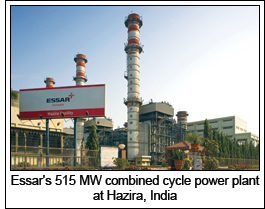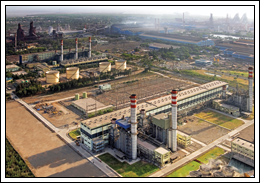 — K.V.B. Reddy,
Executive Director & COO, Essar Power Ltd
Essar Power
— K.V.B. Reddy,
Executive Director & COO, Essar Power Ltd
Essar Power, a subsidiary of
Essar Energy, is one of India's leading
private power producers a total installed generation capacity
exceeding 3 GW. In this exclusive interaction,
K.V.B. Reddy takes
us through the company's operations and its future plans of
attaining 6.7 GW of power capacity by 2014. Reddy also discusses
remedial measures to improve private participation in the power
sector. An interview by
Venugopal Pillai.
To start with, tell us about the current status of two of your
power plants scheduled to commission this year, Mahan-I and
Vadinar-P2.
The coal-fired Vadinar P2 plant, with 510 mw capacity,
providing power and process steam to Essar Oil's Vadinar
refinery, was fully commissioned in November 2012. The plant
has significantly lowered generation costs and improved
refinery margins of Essar Oil.
Mahan I, Essar Power's eighth operational power plant, is a
1,200-mw (2x600 mw) captive coal-fired pit-head power plant
located in Singrauli district in Madhya Pradesh. In December
2012, the Unit I of 600 mw was synchronized with the
transmission grid and unit II (600 mw) is expected to be
commissioned by the first quarter of next fiscal. This 600 mw
capacity is the largest-size single unit commissioned in Madhya
Pradesh.
How is the 1,200-mw Salaya-I commissioned this year faring in
terms of regular operations? Do you have expansion plants at
Salaya?
Salaya Power Plant, located near Essar Oil's refinery complex
at Vadinar, is an imported coal-fueled thermal power plant with
two 600-mw generation units. Coal for the plant will be sourced
from Essar Energy's captive coal mines in Indonesia, which are
under development. In the interim, the coal is imported from
other sources.
Full commercial operations of Salaya-I began in June 2012.
The operations of Salaya I has been stabilized with satisfactory
output. Bulk of the power produced by the Salaya-I plant is
being sold to the Gujarat state electricity utility, Gujarat Urja
Vikas Nigam Ltd, under a long-term contract.
Salaya II and III, with a total capacity of 1,920 mw, are
currently under implementation. These capacities are
expected to be commissioned by March 2014.
Salaya II is a 1,320-mw supercritical coal-fired plant
comprising two 660-mw generating units while Salaya III is a
600-mw circulating fluidised bed combustion technology plant
comprising four units of 150 mw.
Please discuss your plans of attaining, as we understand, over
6,500 mw of power generation capacity by 2014. As you are aware, Essar Power is one of India's largest private
power producers with a 15-year operating track record. We
currently have seven operational power plants in India and one
in Algoma, Canada, with a total installed generation capacity of
3,910 mw. This capacity is increasing to 6,700 mw by March
2014.
 We learn that Essar Power is aggressively pursuing renewable
energy opportunities. We also understand that an agreement
has been reached with wind turbine maker RePower. Please
elaborate.
We learn that Essar Power is aggressively pursuing renewable
energy opportunities. We also understand that an agreement
has been reached with wind turbine maker RePower. Please
elaborate.
Currently almost our entire portfolio of power plants fossil fuel
fired. Our view is that for rapid development of our country, we
need cheap power. Currently, only thermal power - and that too
pit head (for domestic coal) and coastal plants (for imported
coal) - are ideal for that objective. Coal is still the cheapest form
of power. India has vast coal resources and hence it needs to
exploit its resources to provide affordable power for all. As of
now, other energy forms like solar, wind, and hydropower still
have technical and geological challenges.
Essar Energy currently is focused on implementing the
above-mentioned projects. We continue to evaluate
opportunities in the renewable energy space and currently
have only a small portfolio of renewable capacity in the solar
energy space.
We perceive that private power projects, after playing a very
important role in the XI Plan, are now seen slowing down and
adversely affected by a variety of reasons like clearances, coal
linkages, etc. What is your overall view?
You are right. If India is to meet its planned power
generation targets, private sector has to play a major role
and today, owning to various policy-level issues, private
players have slowed down their investments. In the medium
to long term, this will have an adverse impact on the
country's growth.
Currently, the concern is both on the supply and the demand
side. On the supply side, poor availability of fuel (both gas and
coal), transmission capacity bottlenecks, and slow pace of
obtaining statutory approvals for land acquisition are key
factors affecting capacity creation. Several projects at the
development stage are being deferred/kept on hold due to the
above mentioned reasons.
Significant rise in the interest rates over the last few years
has affected fund raising. Availability of plentiful debt capital at
reasonable cost is critical for any business, particularly
infrastructure, as debt typically finances 75 per cent of the
project cost. The current state of capital markets is also not
conducive to raising equity, which has made funding
challenging.
On the demand side, absences of tariff reforms have led to
high losses and financial stress for distribution companies,
which are the main bulk procurers of power. Poor cash flows of
state-owned distribution companies are affecting their ability
to off-take power, which is creating additional uncertainty for
capacity creation.
While the government's target and the actual capacity
addition achieved in the past year is laudable, the challenges
faced by the industry will make the target achievement much
more difficult. However, we remain optimistic that the
government is cognizant of these factors and is taking active
steps to address them.
If you were to make three recommendations to the government
for reviving and expediting private sector investment in the
power (generation) sector, what would they be?
I think our three requests would be quicker approvals, quicker
approvals, and third and the most important, quicker
approvals! Most power projects are stuck or delayed due to
inordinate delays in obtaining the required permission. Hence
it would be a shot in the arm for the industry if government
speeds up its approval process.
Essar Power, as we understand, has placed orders on Chinese
main plant equipment for some of its power projects. What is
your overall view on the sometimes-controversial issue of
Chinese BTG equipment in Indian power plants?
We have placed equipment orders with Chinese firm Harbin
Power, one the China's largest power plant equipment
manufacturers, for BTG packages and other project materials.
We have a good working experience with them and have found
them to be satisfactory.
What has been Essar's level of interest in the Centre's ultra
mega power project series?
We will consider bidding for any project or putting up any new
project only after fuel security is ensured. This has been our
policy even for the capacity we are putting up.
 Tell us about Essar Power's stance in acquiring coal assets
overseas. In view of its significant power generation capacity
coming up, how important would be overseas coal mines in
terms of fuel security?
Tell us about Essar Power's stance in acquiring coal assets
overseas. In view of its significant power generation capacity
coming up, how important would be overseas coal mines in
terms of fuel security?
All our plants are based on assured fuel linkages, since that's
the only way we can be assured of long term raw material
security. Our Salaya Plant is based on coal imported from our
own mine in Indonesia. Mahan Plant will be fed coal from the
linked Mahan Coal block, Tori Plant from Chakla and Ashok
Karkata mines, and Navabharat Plant from Rampia mines.
Owning the complete value chain is very important!
We are always looking for opportunities to meet our long
term fuel security. Acquisition of new mines will also depend on
development of future projects which are currently on hold due
to regulatory hurdles in India.
Having established a solid base as an independent power
producer, what is your take on power transmission and distribution
where tremendous opportunities exist for private enterprise?
We see a lot of opportunity in the power distribution space,
since we believe that the end consumer can benefit a lot if
provided with quality service. We have been evaluating
opportunities being offered by state governments under the
distribution franchisee model.
Untitled Document
PROJECTS UNDER IMPLEMENTATION |
| Plant |
State |
Capacity
(MW) |
| Mahan I (Unit II) |
MP |
600 |
| Hazira II |
GUJ |
270 |
| Paradip |
ORI |
120 |
| Tori I |
JHA |
1,200 |
| Tori II |
JHA |
600 |
| Salaya II |
GUJ |
1,320 |
| Salaya III |
GUJ |
600 |
| Navabharat I |
ORI |
1,050 |
We perceive that Essar Power has been able to producer power
at relatively lower costs. While we feel it could be due to
efficient technology and also due to strong synergies with
group companies, could you elaborate?
We believe in owning the entire the value chain for maximizing
value and lowering cost. For instance, our plants are
designed and commissioned by our sister EPC concern - Essar
Projects. The coal is owned by us hence we are immune
to any fluctuation of prices. The coal is shipped through
another sister concern - Essar Shipping. Essar Ports have
set up a dedicated coal handling port for us at Salaya. Then
we have long term PPA, committing part of our capacity
to Essar Steel and Essar Oil, providing long term
revenue visibility. All this makes us very competitive in terms of
overall costing.
Please take us through your vision for Essar Power over the
next five years, mainly in terms of adding more aspects of the
power value chain to your portfolio.
Essar Power plans to expand the current generation capacity of
3,910 mw to 6,700 mw by March 2014. Currently some of our
projects are on progressing as per meeting regulatory
milestones. Once clarity on the regulatory front emerges, we
will be able to draw our future plans.